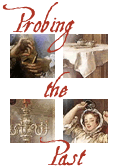Interpreting
Reading Tips
A probate record or inventory is a list of possessions recorded after someone dies. The county court appointed appraisers, local men, to visit an estate, list what was there, and estimate its value. These listings, from a time when household goods were not widely mass-produced, illuminate a family’s routines, rituals, and social relations, as well as a region’s economy and connection to larger markets. Inventories were taken for the head of a household, usually, although not always, a man. In all of these documents, however, there is information about the lives and work of women, children, and slaves.
Reading this list carefully, we can start to ask and answer important questions about life in eighteenth-century Virginia and in early America. How was property valued? What items were expensive? Mahogany? Silk? Silver? What kinds of work did women in this house do? What goods did Sarah Green's and Moore Fauntleroy's estates produce and what did they purchase? What can we learn about the lives of slaves—the work they did and how their labor was valued? How diverse was the slave population in terms of age, gender, and skill level? Were slaves in a given household related?
What to Look For
What is listed first? What kinds of things were expensive? What were inexpensive? How much detail is provided? For example, does the inventory say “a lot of books” or does it list titles? What does this tell us about reading habits? About occupations? About how are books valued? How were items grouped together? What does this tell us about how they were arranged in the house and how they might have been used?
Ask yourself “what is surprising?” Is one item much more expensive than other items? Is it a luxury item? Where was it made? What can you learn about behavior? Did people in this house drink tea or coffee or both? Did they use silverware? What kind of work were people doing in this house?
Additional Reading
Carson, Barbara. Ambitious Appetites: Dining, Behavior, and Patterns of Consumption in Federal Washington. Washington, D.C.: The American Institute of Architects Press, 1990.
Glassie, Henry. Folk Housing in Middle Virginia. Knoxville: The University of Tennessee Press, 1975.
Hurst, Ronald L. and Jonathan Prown. Southern Furniture 1680-1830: The Colonial Williamsburg Collection. New York: The Colonial Williamsburg Foundation, 1997.
Rivoire, J. Richard. Homeplaces: Traditional Domestic Architecture of Charles County, Maryland. La Plata, MD: Southern Maryland Studies Center, Charles County Community College, 1990.

 Sarah Green
Sarah Green